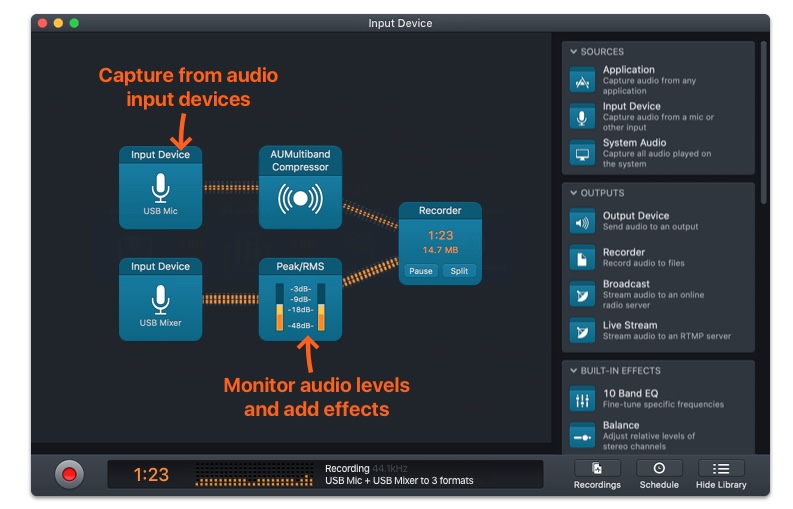
- HOW TO USE REVERB SYSTEM AUDIO HIJACK HOW TO
- HOW TO USE REVERB SYSTEM AUDIO HIJACK DRIVER
- HOW TO USE REVERB SYSTEM AUDIO HIJACK FULL
- HOW TO USE REVERB SYSTEM AUDIO HIJACK PRO
- HOW TO USE REVERB SYSTEM AUDIO HIJACK MAC
HOW TO USE REVERB SYSTEM AUDIO HIJACK FULL
If you have Audio Engineering’s Spectre - a full set of gorgeously designed professional-grade audio meters - you’re in luck, because these meters will allow you to set your NT-USB gain level to a “just right” setting.
HOW TO USE REVERB SYSTEM AUDIO HIJACK PRO
This works the same as in Audio Hijack Pro, with one exception: you can arm the recording channels and set your Input level until the recording level meters in Sound Forge Pro reach the level you want. In Sound Forge Pro you don’t have much choice but to set the gain with the System Preferences panel only. The only way you can strengthen the signal really is by increasing the slider. You can also use several different effects and filters, but these will actually process your signal, not strengthen it. In Logic Pro X you have more options to increase gain, but the easiest and most simple is to crank up the Gain slider to about -4dB. In Audio Hijack Pro you can now increase the VU Meters gain to a level slightly higher than normal and you’ll have set your NT-USB microphone to the best level possible without clipping. On my system, this will be at about 3/4 of the maximum gain the OS X System Preferences Input level can be set. Now, drag the slider until you see the VU Meters move to about -20dB. Switch to the System Preferences but keep the VU Meters somewhere you can see them. First reset the gain in the Audio Hijack Pro VU meters effect to its default setting. You therefore will now increase the gain with the System Preferences. The VU Meters let you boost the input gain, but if your voice is like mine, you’ll never get to a level that’s higher than -20dB.
HOW TO USE REVERB SYSTEM AUDIO HIJACK HOW TO
Go to the Effects tab and select the VU Meters effect from the effects list (I’m assuming you know how to work Audio Hijack Pro - if you don’t, then read the manual first). But again, these level meters are only an indication that something is happening. The blue input level meters should work when you speak into the microphone. In the Input tab, select Audio Device as Source Type and Røde NT-USB as Input Device.

If you have Audio Hijack on your system, open it now. The Audio MIDI Setup control panel of OS X isn’t going to help you either as that panel doesn’t have an input level gauge at all. We can fix that by cranking up the gain with the slider, but the System Preferences Input level display gives too little feedback to be of use. The gain is too low if you don’t speak in a loud voice. Now speak at a normal voice and look at the Input level. 15cm is about the distance between your little finger and your thumb, both stretched outwards. Place the NT-USB at 15cm from your mouth. By default, you’ll notice the gain setting for the Røde microphone to be identical as the setting for any microphone, i.e. As soon as you connected the NT-USB, the microphone appeared in both the Inout and Outout tabs. Open OS X’s System Preferences panel and select the Sound tab. I’m assuming you have your NT-USB mounted on its included mic stand with the pop filter in place. A direct connection is always preferred when working with audio equipment, but if you don’t have open USB ports, a hub will do fine too. If you have one available on your Mac, use that one. The first thing we’ll need to do is connect the NT-USB to a USB port. I used Audio Engineering’s Spectre for metering, Logic Pro X and Sound Forge 2.


As for audio editors, Audio Hijack is great, but Sony Sound Forge Pro 2 is better because it has more features that we can use for optimisation of the input signal. Your DAW could be Logic Pro X, Reason or ProTools.
HOW TO USE REVERB SYSTEM AUDIO HIJACK MAC
You’ll need a DAW (Digital Audio Station – music creation software) or an audio editor, a Røde NT-USB mic and a Mac for this setup walkthrough. Here is how you set it for optimum results. The NT-USB has an optimised gain for its internal circuits, but unless you have a loud voice, that gain setting may be too low. To get best results from a USB microphone you need to set the gain correctly.
HOW TO USE REVERB SYSTEM AUDIO HIJACK DRIVER
USB microphones have one major benefit: you don’t need a driver or an ADC (Analogue-Digital-Converter) to make it work.


 0 kommentar(er)
0 kommentar(er)
